Systems Thinking In Public Health
VerifiedAdded on 2021/01/02
|8
|1733
|195
AI Summary
Contribute Materials
Your contribution can guide someone’s learning journey. Share your
documents today.

APPLYING SYSTEMS THINKING IN
PUBLIC HEALTH
PUBLIC HEALTH
Secure Best Marks with AI Grader
Need help grading? Try our AI Grader for instant feedback on your assignments.
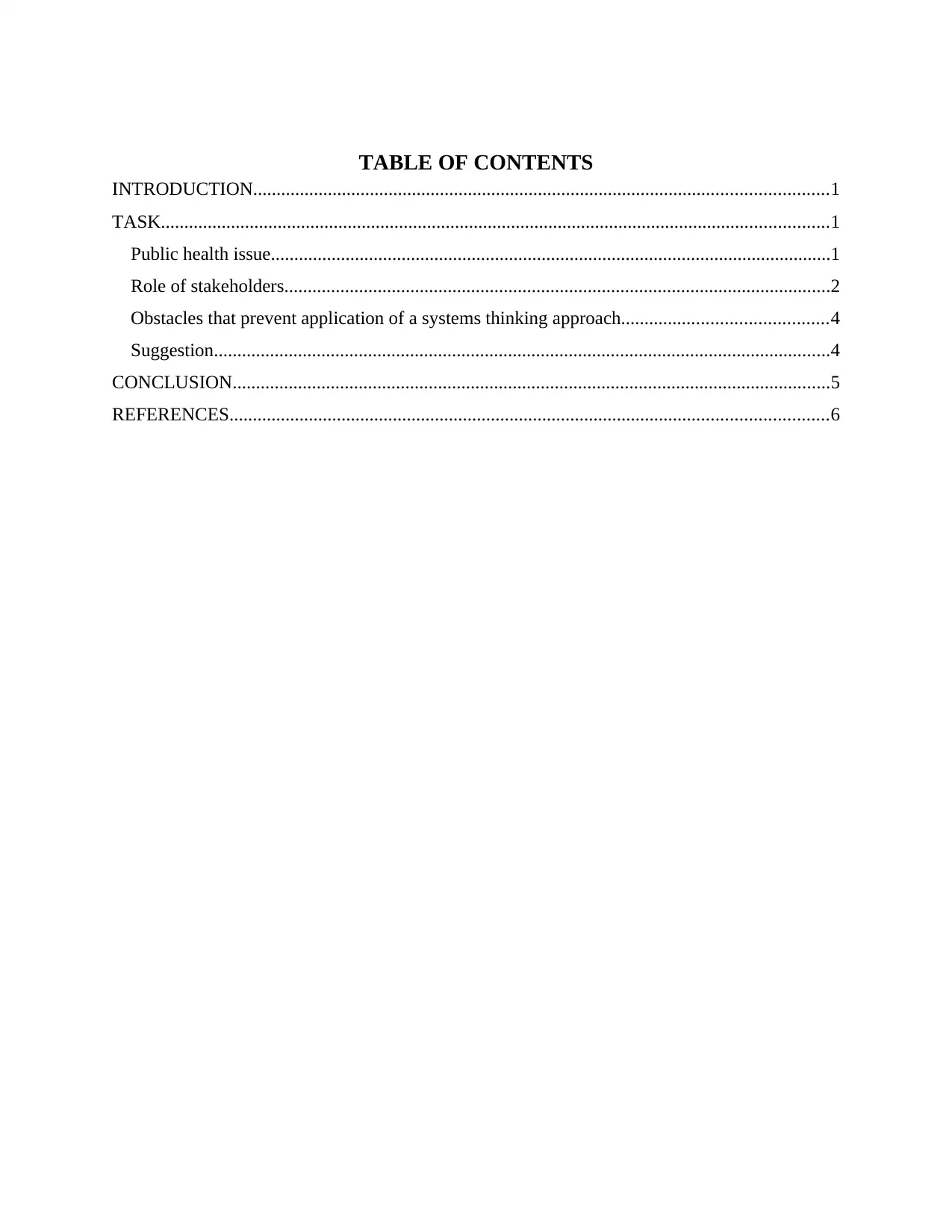
TABLE OF CONTENTS
INTRODUCTION...........................................................................................................................1
TASK...............................................................................................................................................1
Public health issue........................................................................................................................1
Role of stakeholders.....................................................................................................................2
Obstacles that prevent application of a systems thinking approach............................................4
Suggestion....................................................................................................................................4
CONCLUSION................................................................................................................................5
REFERENCES................................................................................................................................6
INTRODUCTION...........................................................................................................................1
TASK...............................................................................................................................................1
Public health issue........................................................................................................................1
Role of stakeholders.....................................................................................................................2
Obstacles that prevent application of a systems thinking approach............................................4
Suggestion....................................................................................................................................4
CONCLUSION................................................................................................................................5
REFERENCES................................................................................................................................6
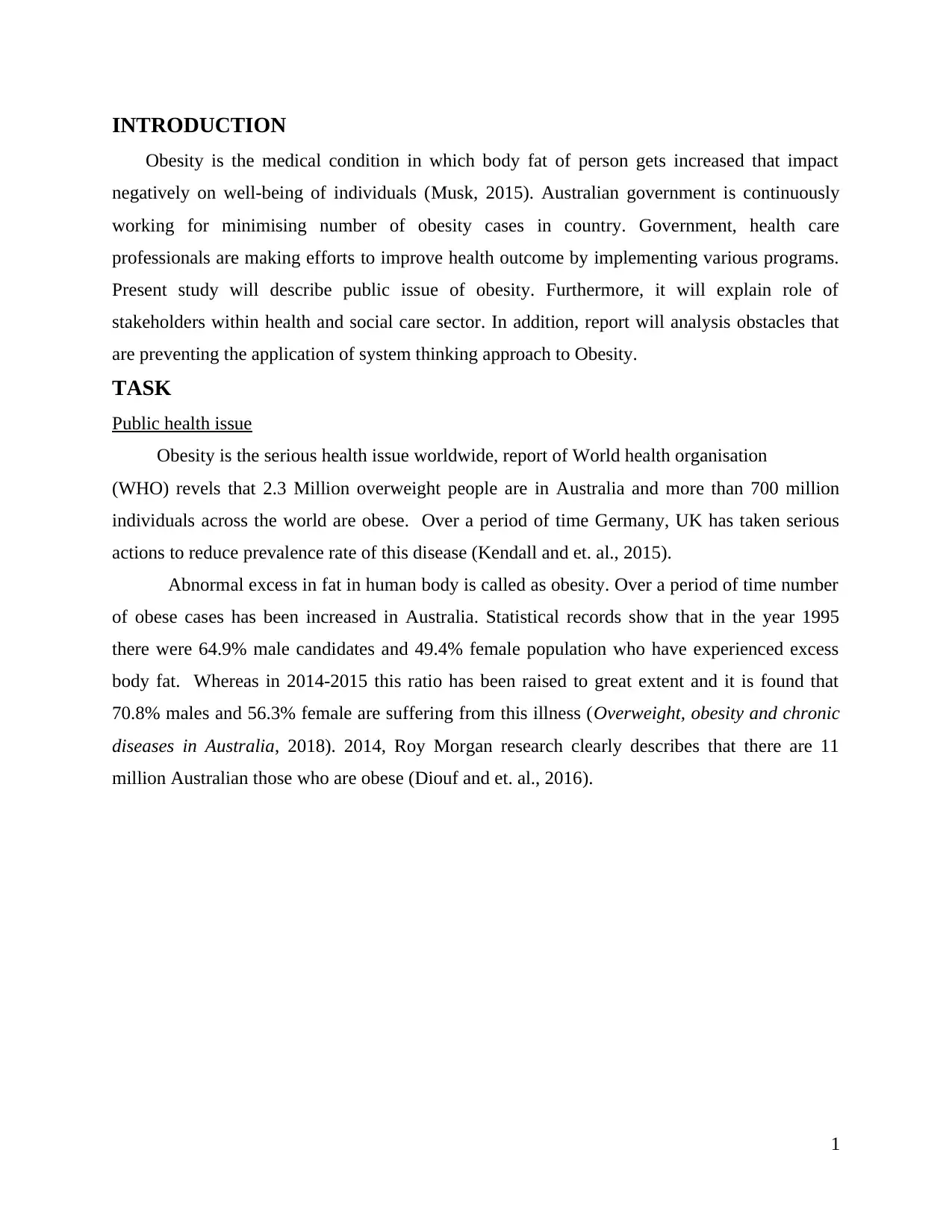
INTRODUCTION
Obesity is the medical condition in which body fat of person gets increased that impact
negatively on well-being of individuals (Musk, 2015). Australian government is continuously
working for minimising number of obesity cases in country. Government, health care
professionals are making efforts to improve health outcome by implementing various programs.
Present study will describe public issue of obesity. Furthermore, it will explain role of
stakeholders within health and social care sector. In addition, report will analysis obstacles that
are preventing the application of system thinking approach to Obesity.
TASK
Public health issue
Obesity is the serious health issue worldwide, report of World health organisation
(WHO) revels that 2.3 Million overweight people are in Australia and more than 700 million
individuals across the world are obese. Over a period of time Germany, UK has taken serious
actions to reduce prevalence rate of this disease (Kendall and et. al., 2015).
Abnormal excess in fat in human body is called as obesity. Over a period of time number
of obese cases has been increased in Australia. Statistical records show that in the year 1995
there were 64.9% male candidates and 49.4% female population who have experienced excess
body fat. Whereas in 2014-2015 this ratio has been raised to great extent and it is found that
70.8% males and 56.3% female are suffering from this illness (Overweight, obesity and chronic
diseases in Australia, 2018). 2014, Roy Morgan research clearly describes that there are 11
million Australian those who are obese (Diouf and et. al., 2016).
1
Obesity is the medical condition in which body fat of person gets increased that impact
negatively on well-being of individuals (Musk, 2015). Australian government is continuously
working for minimising number of obesity cases in country. Government, health care
professionals are making efforts to improve health outcome by implementing various programs.
Present study will describe public issue of obesity. Furthermore, it will explain role of
stakeholders within health and social care sector. In addition, report will analysis obstacles that
are preventing the application of system thinking approach to Obesity.
TASK
Public health issue
Obesity is the serious health issue worldwide, report of World health organisation
(WHO) revels that 2.3 Million overweight people are in Australia and more than 700 million
individuals across the world are obese. Over a period of time Germany, UK has taken serious
actions to reduce prevalence rate of this disease (Kendall and et. al., 2015).
Abnormal excess in fat in human body is called as obesity. Over a period of time number
of obese cases has been increased in Australia. Statistical records show that in the year 1995
there were 64.9% male candidates and 49.4% female population who have experienced excess
body fat. Whereas in 2014-2015 this ratio has been raised to great extent and it is found that
70.8% males and 56.3% female are suffering from this illness (Overweight, obesity and chronic
diseases in Australia, 2018). 2014, Roy Morgan research clearly describes that there are 11
million Australian those who are obese (Diouf and et. al., 2016).
1
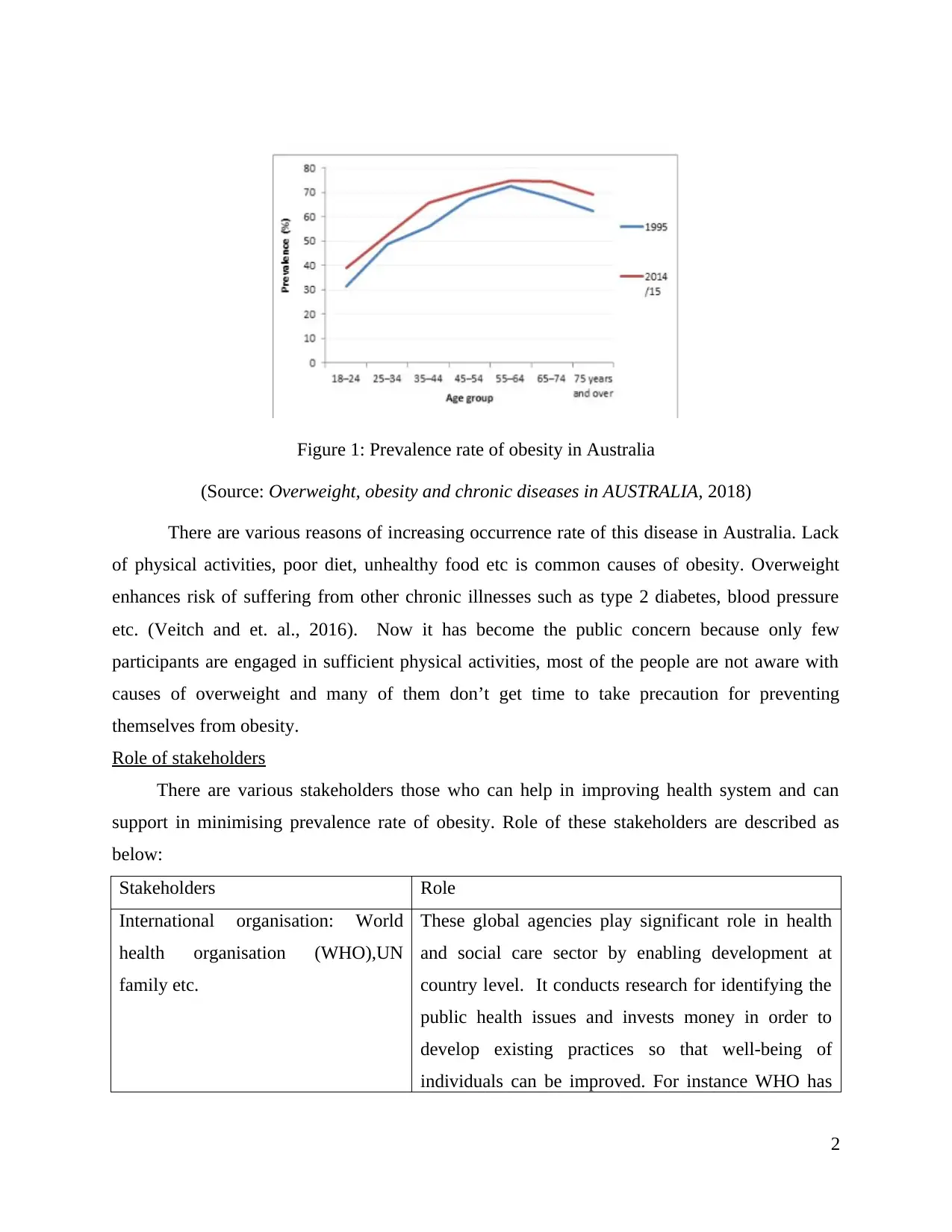
Figure 1: Prevalence rate of obesity in Australia
(Source: Overweight, obesity and chronic diseases in AUSTRALIA, 2018)
There are various reasons of increasing occurrence rate of this disease in Australia. Lack
of physical activities, poor diet, unhealthy food etc is common causes of obesity. Overweight
enhances risk of suffering from other chronic illnesses such as type 2 diabetes, blood pressure
etc. (Veitch and et. al., 2016). Now it has become the public concern because only few
participants are engaged in sufficient physical activities, most of the people are not aware with
causes of overweight and many of them don’t get time to take precaution for preventing
themselves from obesity.
Role of stakeholders
There are various stakeholders those who can help in improving health system and can
support in minimising prevalence rate of obesity. Role of these stakeholders are described as
below:
Stakeholders Role
International organisation: World
health organisation (WHO),UN
family etc.
These global agencies play significant role in health
and social care sector by enabling development at
country level. It conducts research for identifying the
public health issues and invests money in order to
develop existing practices so that well-being of
individuals can be improved. For instance WHO has
2
(Source: Overweight, obesity and chronic diseases in AUSTRALIA, 2018)
There are various reasons of increasing occurrence rate of this disease in Australia. Lack
of physical activities, poor diet, unhealthy food etc is common causes of obesity. Overweight
enhances risk of suffering from other chronic illnesses such as type 2 diabetes, blood pressure
etc. (Veitch and et. al., 2016). Now it has become the public concern because only few
participants are engaged in sufficient physical activities, most of the people are not aware with
causes of overweight and many of them don’t get time to take precaution for preventing
themselves from obesity.
Role of stakeholders
There are various stakeholders those who can help in improving health system and can
support in minimising prevalence rate of obesity. Role of these stakeholders are described as
below:
Stakeholders Role
International organisation: World
health organisation (WHO),UN
family etc.
These global agencies play significant role in health
and social care sector by enabling development at
country level. It conducts research for identifying the
public health issues and invests money in order to
develop existing practices so that well-being of
individuals can be improved. For instance WHO has
2
Secure Best Marks with AI Grader
Need help grading? Try our AI Grader for instant feedback on your assignments.
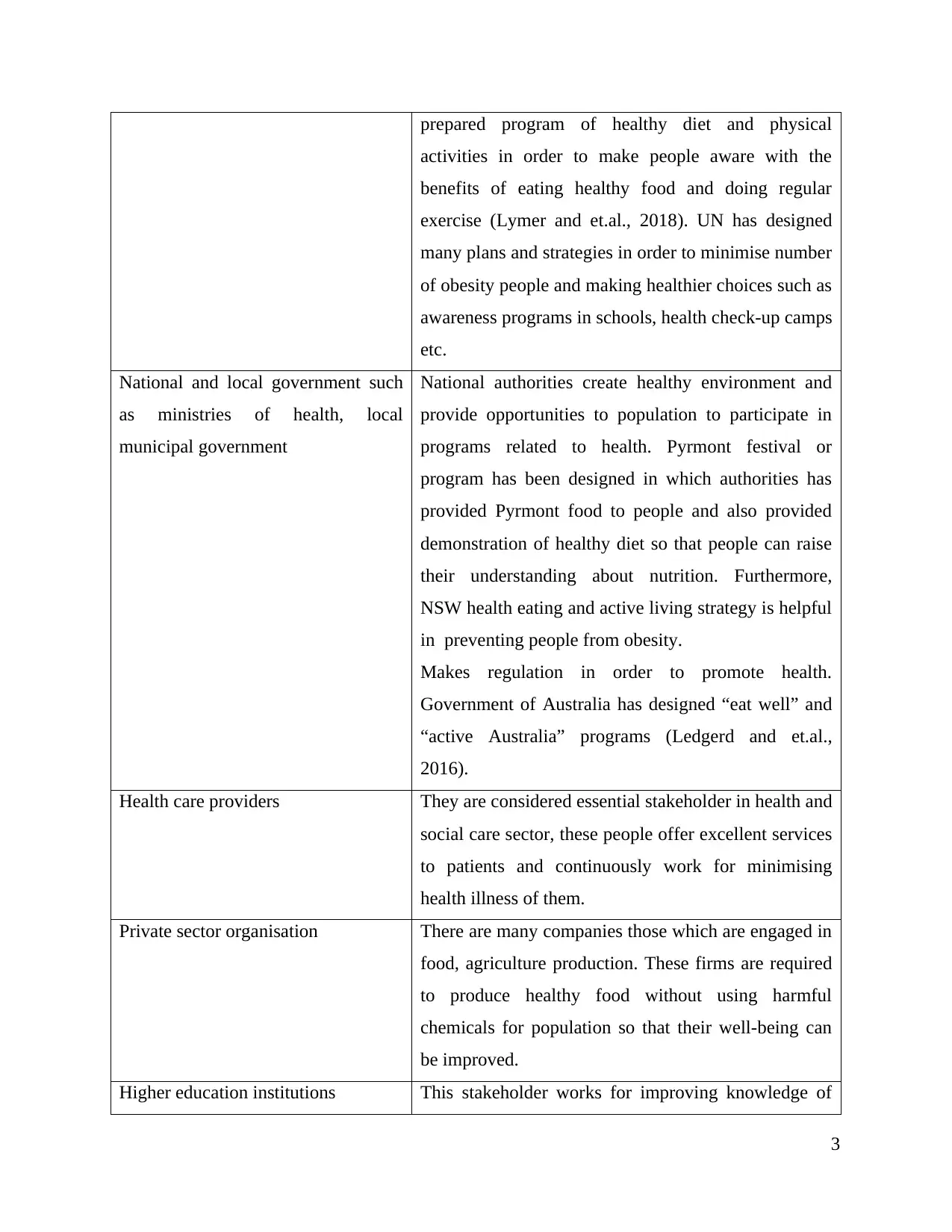
prepared program of healthy diet and physical
activities in order to make people aware with the
benefits of eating healthy food and doing regular
exercise (Lymer and et.al., 2018). UN has designed
many plans and strategies in order to minimise number
of obesity people and making healthier choices such as
awareness programs in schools, health check-up camps
etc.
National and local government such
as ministries of health, local
municipal government
National authorities create healthy environment and
provide opportunities to population to participate in
programs related to health. Pyrmont festival or
program has been designed in which authorities has
provided Pyrmont food to people and also provided
demonstration of healthy diet so that people can raise
their understanding about nutrition. Furthermore,
NSW health eating and active living strategy is helpful
in preventing people from obesity.
Makes regulation in order to promote health.
Government of Australia has designed “eat well” and
“active Australia” programs (Ledgerd and et.al.,
2016).
Health care providers They are considered essential stakeholder in health and
social care sector, these people offer excellent services
to patients and continuously work for minimising
health illness of them.
Private sector organisation There are many companies those which are engaged in
food, agriculture production. These firms are required
to produce healthy food without using harmful
chemicals for population so that their well-being can
be improved.
Higher education institutions This stakeholder works for improving knowledge of
3
activities in order to make people aware with the
benefits of eating healthy food and doing regular
exercise (Lymer and et.al., 2018). UN has designed
many plans and strategies in order to minimise number
of obesity people and making healthier choices such as
awareness programs in schools, health check-up camps
etc.
National and local government such
as ministries of health, local
municipal government
National authorities create healthy environment and
provide opportunities to population to participate in
programs related to health. Pyrmont festival or
program has been designed in which authorities has
provided Pyrmont food to people and also provided
demonstration of healthy diet so that people can raise
their understanding about nutrition. Furthermore,
NSW health eating and active living strategy is helpful
in preventing people from obesity.
Makes regulation in order to promote health.
Government of Australia has designed “eat well” and
“active Australia” programs (Ledgerd and et.al.,
2016).
Health care providers They are considered essential stakeholder in health and
social care sector, these people offer excellent services
to patients and continuously work for minimising
health illness of them.
Private sector organisation There are many companies those which are engaged in
food, agriculture production. These firms are required
to produce healthy food without using harmful
chemicals for population so that their well-being can
be improved.
Higher education institutions This stakeholder works for improving knowledge of
3

people by organising training programs. Such
institutions get rewards for their amazing contribution
in society. Such educational institutes organising
camps to make people aware with healthy diet so that
their knowledge can be increased and people can
prevent themselves from obesity type of diseases
(Systems Thinking to Improve the Public’s Health,
2014).
Health care professional regulators Their role is to maintain register and ensure that all
medical professionals meet standard and provide
excellent services to patients (Dickinson and O'Flynn,
2016).
Obstacles that prevent application of a systems thinking approach
There are many obstacles that create issue for authorities in preventing people from
obesity. Policy interventions: It is one of the major issues because changes in rules and
regulations create trouble for health care professionals and ultimately affecting the
physical health of the population. They have to make modification in existing. This
requires redesigning of entire health care practices (Vickers and et.al., 2017). Lack of availability of fund: Many times local government plans to implements
programs for making people aware with causes of obesity and its prevention methods.
Due to lack of financial resources and unavailability of required budget, authorities fail to
implement such effective programs that can improve well-being of population.
Education: One of the major challenges faced by authorities in their prevention programs
is poor educational level of the population. This creates issue for authorities in promoting
health (Overweight, obesity and chronic diseases in Australia, 2018).
Suggestion
There are various ways through which system thinking approach can be improved. These are
described as below:
4
institutions get rewards for their amazing contribution
in society. Such educational institutes organising
camps to make people aware with healthy diet so that
their knowledge can be increased and people can
prevent themselves from obesity type of diseases
(Systems Thinking to Improve the Public’s Health,
2014).
Health care professional regulators Their role is to maintain register and ensure that all
medical professionals meet standard and provide
excellent services to patients (Dickinson and O'Flynn,
2016).
Obstacles that prevent application of a systems thinking approach
There are many obstacles that create issue for authorities in preventing people from
obesity. Policy interventions: It is one of the major issues because changes in rules and
regulations create trouble for health care professionals and ultimately affecting the
physical health of the population. They have to make modification in existing. This
requires redesigning of entire health care practices (Vickers and et.al., 2017). Lack of availability of fund: Many times local government plans to implements
programs for making people aware with causes of obesity and its prevention methods.
Due to lack of financial resources and unavailability of required budget, authorities fail to
implement such effective programs that can improve well-being of population.
Education: One of the major challenges faced by authorities in their prevention programs
is poor educational level of the population. This creates issue for authorities in promoting
health (Overweight, obesity and chronic diseases in Australia, 2018).
Suggestion
There are various ways through which system thinking approach can be improved. These are
described as below:
4
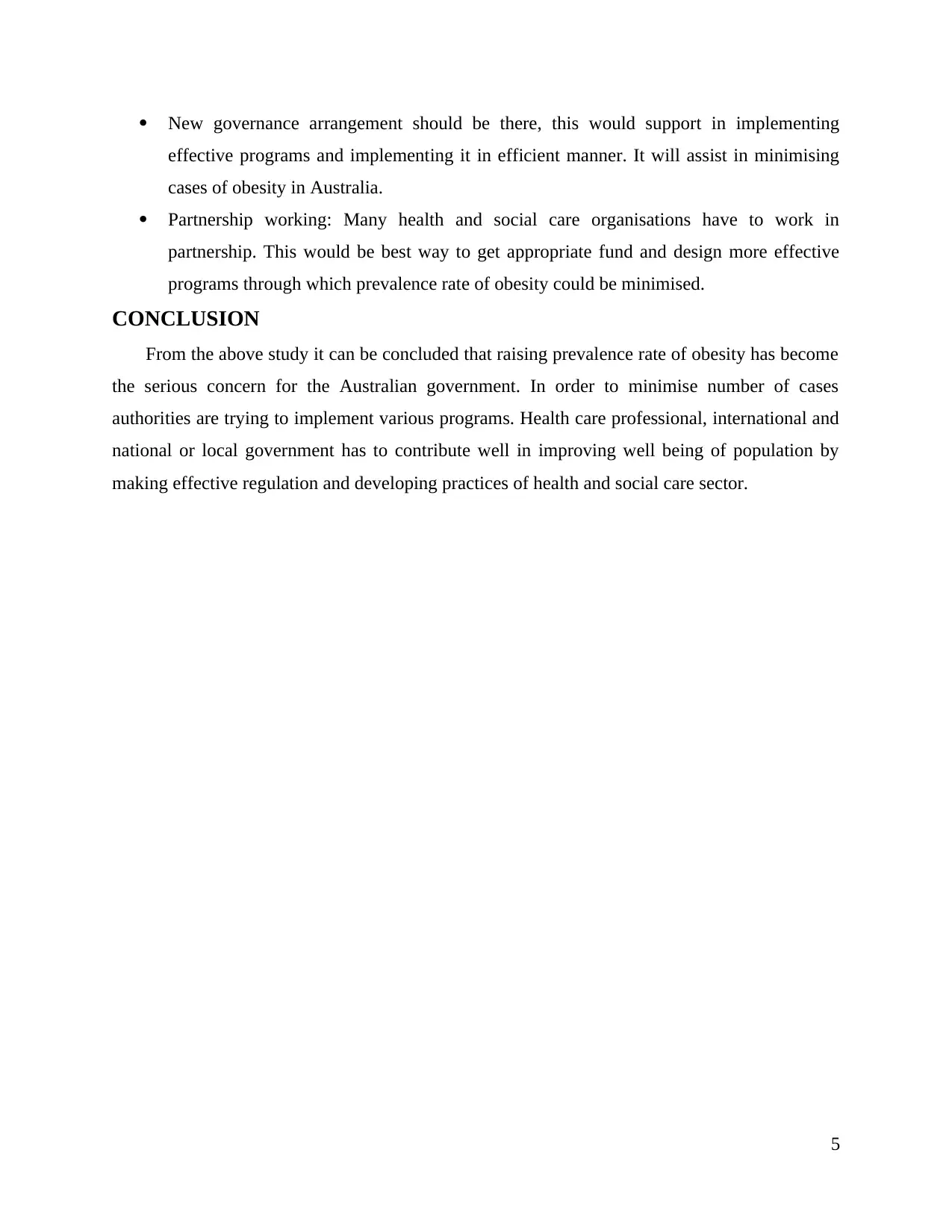
New governance arrangement should be there, this would support in implementing
effective programs and implementing it in efficient manner. It will assist in minimising
cases of obesity in Australia.
Partnership working: Many health and social care organisations have to work in
partnership. This would be best way to get appropriate fund and design more effective
programs through which prevalence rate of obesity could be minimised.
CONCLUSION
From the above study it can be concluded that raising prevalence rate of obesity has become
the serious concern for the Australian government. In order to minimise number of cases
authorities are trying to implement various programs. Health care professional, international and
national or local government has to contribute well in improving well being of population by
making effective regulation and developing practices of health and social care sector.
5
effective programs and implementing it in efficient manner. It will assist in minimising
cases of obesity in Australia.
Partnership working: Many health and social care organisations have to work in
partnership. This would be best way to get appropriate fund and design more effective
programs through which prevalence rate of obesity could be minimised.
CONCLUSION
From the above study it can be concluded that raising prevalence rate of obesity has become
the serious concern for the Australian government. In order to minimise number of cases
authorities are trying to implement various programs. Health care professional, international and
national or local government has to contribute well in improving well being of population by
making effective regulation and developing practices of health and social care sector.
5
Paraphrase This Document
Need a fresh take? Get an instant paraphrase of this document with our AI Paraphraser
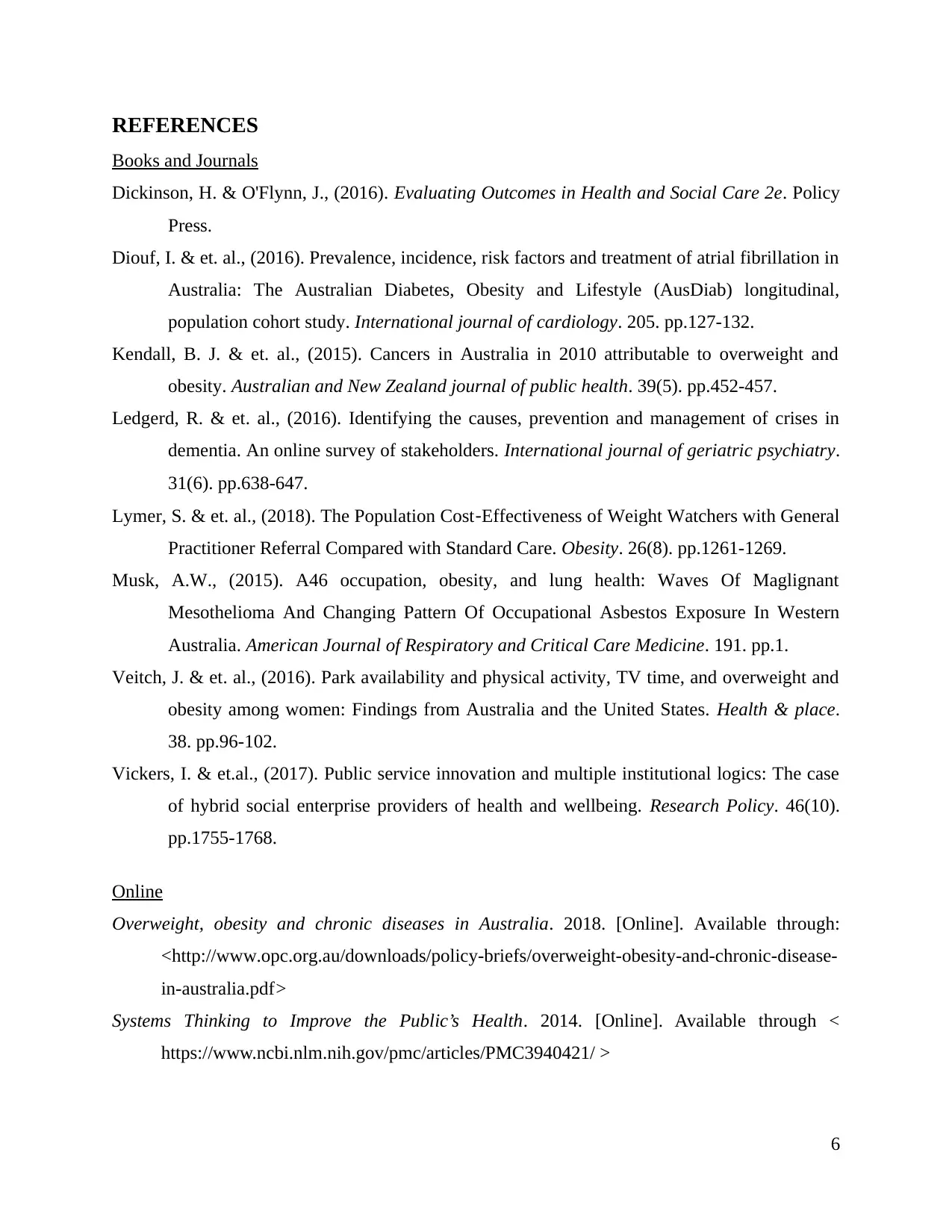
REFERENCES
Books and Journals
Dickinson, H. & O'Flynn, J., (2016). Evaluating Outcomes in Health and Social Care 2e. Policy
Press.
Diouf, I. & et. al., (2016). Prevalence, incidence, risk factors and treatment of atrial fibrillation in
Australia: The Australian Diabetes, Obesity and Lifestyle (AusDiab) longitudinal,
population cohort study. International journal of cardiology. 205. pp.127-132.
Kendall, B. J. & et. al., (2015). Cancers in Australia in 2010 attributable to overweight and
obesity. Australian and New Zealand journal of public health. 39(5). pp.452-457.
Ledgerd, R. & et. al., (2016). Identifying the causes, prevention and management of crises in
dementia. An online survey of stakeholders. International journal of geriatric psychiatry.
31(6). pp.638-647.
Lymer, S. & et. al., (2018). The Population Cost‐Effectiveness of Weight Watchers with General
Practitioner Referral Compared with Standard Care. Obesity. 26(8). pp.1261-1269.
Musk, A.W., (2015). A46 occupation, obesity, and lung health: Waves Of Maglignant
Mesothelioma And Changing Pattern Of Occupational Asbestos Exposure In Western
Australia. American Journal of Respiratory and Critical Care Medicine. 191. pp.1.
Veitch, J. & et. al., (2016). Park availability and physical activity, TV time, and overweight and
obesity among women: Findings from Australia and the United States. Health & place.
38. pp.96-102.
Vickers, I. & et.al., (2017). Public service innovation and multiple institutional logics: The case
of hybrid social enterprise providers of health and wellbeing. Research Policy. 46(10).
pp.1755-1768.
Online
Overweight, obesity and chronic diseases in Australia. 2018. [Online]. Available through:
<http://www.opc.org.au/downloads/policy-briefs/overweight-obesity-and-chronic-disease-
in-australia.pdf>
Systems Thinking to Improve the Public’s Health. 2014. [Online]. Available through <
https://www.ncbi.nlm.nih.gov/pmc/articles/PMC3940421/ >
6
Books and Journals
Dickinson, H. & O'Flynn, J., (2016). Evaluating Outcomes in Health and Social Care 2e. Policy
Press.
Diouf, I. & et. al., (2016). Prevalence, incidence, risk factors and treatment of atrial fibrillation in
Australia: The Australian Diabetes, Obesity and Lifestyle (AusDiab) longitudinal,
population cohort study. International journal of cardiology. 205. pp.127-132.
Kendall, B. J. & et. al., (2015). Cancers in Australia in 2010 attributable to overweight and
obesity. Australian and New Zealand journal of public health. 39(5). pp.452-457.
Ledgerd, R. & et. al., (2016). Identifying the causes, prevention and management of crises in
dementia. An online survey of stakeholders. International journal of geriatric psychiatry.
31(6). pp.638-647.
Lymer, S. & et. al., (2018). The Population Cost‐Effectiveness of Weight Watchers with General
Practitioner Referral Compared with Standard Care. Obesity. 26(8). pp.1261-1269.
Musk, A.W., (2015). A46 occupation, obesity, and lung health: Waves Of Maglignant
Mesothelioma And Changing Pattern Of Occupational Asbestos Exposure In Western
Australia. American Journal of Respiratory and Critical Care Medicine. 191. pp.1.
Veitch, J. & et. al., (2016). Park availability and physical activity, TV time, and overweight and
obesity among women: Findings from Australia and the United States. Health & place.
38. pp.96-102.
Vickers, I. & et.al., (2017). Public service innovation and multiple institutional logics: The case
of hybrid social enterprise providers of health and wellbeing. Research Policy. 46(10).
pp.1755-1768.
Online
Overweight, obesity and chronic diseases in Australia. 2018. [Online]. Available through:
<http://www.opc.org.au/downloads/policy-briefs/overweight-obesity-and-chronic-disease-
in-australia.pdf>
Systems Thinking to Improve the Public’s Health. 2014. [Online]. Available through <
https://www.ncbi.nlm.nih.gov/pmc/articles/PMC3940421/ >
6
1 out of 8
Related Documents
Your All-in-One AI-Powered Toolkit for Academic Success.
+13062052269
info@desklib.com
Available 24*7 on WhatsApp / Email
![[object Object]](/_next/static/media/star-bottom.7253800d.svg)
Unlock your academic potential
© 2024 | Zucol Services PVT LTD | All rights reserved.





